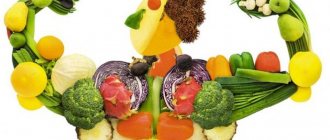Cooking and eating
Boiled and baked products, less often - fried and stewed. Meals 6 times a day: 1st breakfast, 2nd breakfast, lunch, afternoon snack, dinner and at night.
Allowed
Bread and flour products: rye, protein-bran, protein-wheat, wheat from 2nd grade flour, on average 300 g per day
Soups: vegetable, cabbage soup, borscht, beetroot soup, okroshka, weak low-fat meat, fish and mushroom broths with vegetables and permitted cereals, potatoes and meatballs
Meat, poultry: lean beef, veal, pork (trimmed, meat), lamb, rabbit, chickens and turkeys after boiling, dietary sausages and sausages, tongue, liver – limited
Fish: low-fat types, canned fish in its own juice or tomato
Dairy products: milk and fermented milk products, semi-fat and low-fat cottage cheese, limited sour cream, unsalted and low-fat cheese
Eggs: 1-1.5 pcs. per day soft-boiled, white omelettes
Cereals: porridge from buckwheat, barley, millet, pearl barley, oatmeal, legumes
Vegetables: cabbage, zucchini, pumpkin, lettuce, cucumbers, tomatoes, eggplants, with restrictions: green peas, potatoes, carrots, beets. Can be eaten raw
Fruits, sweet dishes: fresh fruits and berries of sweet and sour varieties in any form, jellies, mousses, compotes, candies and cookies with xylitol, sorbitol or saccharin. Limited honey
Sauces and spices: low-fat sauces based on weak meat, fish and mushroom broths, vegetable broth. Limited: pepper, horseradish, mustard
Drinks: tea, coffee with milk, juices from vegetables, low-sweet fruits and berries, rosehip decoction Fats: unsalted butter and ghee, vegetable oils for dishes
Must be excluded
Products made from butter and puff pastry, cakes, strong, fatty broths, milk soups with semolina, rice, noodles, fatty meats, duck, goose, smoked meats, most sausages, fatty fish, salted fish, canned fish in oil, caviar , salty cheeses, cream, sweet curd cheeses, rice, semolina, limit pasta, salted and pickled vegetables, grapes, raisins, bananas, figs, dates, jam, candies, ice cream, grape and other sweet juices, carbonated drinks and lemonades , animal and cooking fats, alcoholic beverages. Daily sugar intake is determined by your doctor and usually depends on the dose of insulin.
Download and print:
Diet No. 9
Make an appointment Do not self-medicate. Contact our specialists who will correctly diagnose and prescribe treatment.
Menu for the week
As an example, a possible menu of “Diet No. 9” is presented for every day for patients suffering from diabetes mellitus of the second degree, that is, non-insulin dependent.
Monday:
- first breakfast: low-fat cottage cheese - 200 g with berries - 40 g;
- second breakfast: one glass of kefir;
- lunch: vegetable soup – 150 ml, baked lamb – 150 g, stewed vegetables – 100 g;
- afternoon snack: cabbage and cucumber salad, dressed with olive oil - 100 g;
- dinner: grilled dorado fish – 200 g, steamed vegetables – 100 g.
Tuesday:
- first breakfast: buckwheat porridge with milk 150 g;
- second breakfast: two green apples;
- lunch: borscht (without meat) - 150 ml, boiled beef - 150 g, dried fruit compote without sugar;
- afternoon snack: rosehip decoction – 150 ml;
- dinner: boiled fish – 200 g, fresh vegetables – 150 g.
Wednesday:
- first breakfast: cottage cheese casserole - 150 g,
- second breakfast: rosehip decoction - 200 ml;
- lunch: fresh cabbage soup (without meat) – 150 ml, fish cutlets – 150 g, fresh vegetables – 100 g;
- afternoon snack: boiled egg;
- dinner: steamed meat cutlets – 200 g, stewed cabbage – 150 g.
Thursday:
- first breakfast: two-egg omelette with vegetables 150 g;
- second breakfast: drinking yoghurt - 150 ml;
- lunch: broccoli cream soup – 150 ml, stuffed peppers – 200 g;
- afternoon snack: carrot casserole with cottage cheese - 200 g;
- dinner: chicken kebab – 200 g, grilled vegetables – 150 g.
Friday:
- first breakfast: millet porridge 150 g, apple;
- second breakfast: 2 oranges;
- lunch: fish soup 200 ml, meat goulash - 100 g, pearl barley porridge - 100 g;
- afternoon snack: a glass of kefir, bran – 100 g;
- dinner: meat cutlets – 150 g, buckwheat porridge – 100 g, baked asparagus – 70 g.
Saturday:
- first breakfast: bran - 150 g, apple;
- second breakfast: soft-boiled egg;
- lunch: vegetable stew with pieces of meat (beef or lamb) – 200 g;
- afternoon snack: salad of tomatoes and celery stalks – 150 g;
- dinner: stewed lamb with vegetables – 250 g.
Sunday:
- first breakfast: low-fat cottage cheese 100 g with yogurt 50 g;
- second breakfast: grilled chicken breast - 100 g;
- lunch: vegetable soup – 150 ml, meat goulash – 100 g, salad of celery stalks and apples – 100 g;
- afternoon snack: berries – 125 g;
- dinner: boiled shrimp – 200 g, steamed green beans – 100 g.
menu for the week.
Dish recipes
Healthy recipes suitable for the “9 table” diet.
Diet cutlets
To prepare you will need 200 g of lean meat, 30 g of rye bread, 10 g of butter, a small onion, 40 ml of low-fat milk, salt, seasonings.
Cooking process:
- Rinse the meat, remove tendons and pass through a meat grinder;
- Soak the bread in milk;
- Finely chop the onion and add to the minced meat;
- Salt, pepper to taste;
- Form into small patties and place on a greased baking sheet;
- Cook for 20 minutes in the oven at 180 degrees Celsius.
Pollock in Tatar style
To prepare you will need 200 g of lean fish fillet, a quarter of a lemon, 30 g of low-fat sour cream, olives, herbs, olive oil.
Cooking process:
- Add 20 ml of olive oil to the baking dish, lay out the fish pieces;
- Sprinkle the fillet with lemon juice;
- Place in the oven preheated to 170 degrees Celsius for 5 minutes;
- Then add sour cream, olives, zest, salt and simmer for another 20 minutes;
- Before serving, add finely chopped herbs.
Diet pudding
The following ingredients will be required: 200 g of zucchini, 100 g of apples, 30 ml of milk, 4 tbsp. l. rye flour, egg, tbsp. l. butter, 40 g low-fat sour cream.
Cooking process:
- Peel the apples and remove seeds, grate them on a coarse grater, just like zucchini;
- Add milk, flour, butter, egg, mix well;
- Pour into the mold, place in the oven for 25 minutes at 180 degrees Celsius;
- You can season it with low-fat sour cream before serving.
Dietary nutrition for type 1 diabetes
In type 1 diabetes, the cells of the pancreas are destroyed, and the lack of insulin is compensated for by injections of insulin-containing drugs. It is important to control the dose and duration of insulin, as well as the amount of food consumed. Extreme attention must be paid to bread units (XE), 1 unit of XE = 10–12 g of carbohydrates. The daily norm should not be more than 25 XE, which means that you should not consume more than 4-5 XE at one meal. The number of bread units consumed must be calculated in order to correctly select the dose of insulin needed to digest foods.
Nutrition must be clearly balanced in chemical composition and include all the necessary vitamins and microelements. The approximate chemical composition looks like this: 100 g of proteins, 80 g of fats, 450 g of carbohydrates. The energy value will be approximately 2500 kcal.
The temperature of hot dishes should not exceed 60° C, and for salads and snacks - 15° C.
IMPORTANT! Consumption of clean water per day should be at least 1.5–2 liters.
Small, balanced and timely meals are the key to success on the path to diabetes treatment
Approximate daily diet including insulin intake:
- 8:00 – mainly protein foods (eggs, cottage cheese, meat);
- 8:15 – taking insulin medication;
- 9:00 – intake of carbohydrate foods (porridge, rye bread, potatoes);
- 12:00 – carbohydrate-containing food (bread allowed);
- 14:00 – lunch (without eating bread);
- 17:00 – taking insulin medication;
- 18:00 – carbohydrate-containing food (bread allowed);
- 20:00 – carbohydrate-containing food.
IMPORTANT! Failure to comply with the diet for type 1 diabetes leads to the occurrence of hyperglycemic coma.
Nutrition rules for every day
- Eat more dietary fiber. There is evidence of a reduction in mortality in people with diabetes when fiber is added to their diet (at least 14 g per 1000 g of food eaten).
- Limit the content of trans fats as much as possible: on product labels they are designated as “hydrogenated vegetable fats”, “margarine”, “milk fat substitute”, etc. 8
- Reduce the amount of sugars, refined grains and high-starchy foods.
- Replace sugar with sweeteners.
- Give preference to whole foods. 9
Diet 9 during pregnancy and lactation
Diabetes mellitus can have a latent form and first manifests itself during pregnancy . This is true diabetes mellitus . Gestational diabetes may occur , which appears during pregnancy due to a decrease in tissue sensitivity to insulin. After delivery, there is a possibility of normalization of carbohydrate metabolism. However, there is a risk of developing diabetes in the future.
High glucose levels pose a danger to mother and child: risk of miscarriage , pyelonephritis , fundus vascular complications and complications during childbirth. Therefore, it is so important for pregnant women to regularly monitor sugar levels and follow nutritional recommendations if they increase.
- The diet completely excludes “simple” carbohydrates, which cause a sharp increase in blood sugar, and limits the amount of complex carbohydrates. Eliminate sweets, sugary carbonated drinks, white bread, grapes, bananas, sweet juices and dried fruits. Eat foods that contain fiber, which slows down the flow of glucose into the blood. Its sources are vegetables and unsweetened fruits.
- Pasta and potatoes should be present in small quantities.
- It is recommended to eat every two hours. There should be three main meals and two additional ones. After dinner, you can drink half a glass of kefir or eat half an apple.
- Throughout the day, constantly measure your glucose level after meals (to do this, you need to purchase a glucometer).
- Eliminate fatty foods and fried foods, fast food products. It is recommended to avoid sausage and smoked meats.
- Do not limit fluid intake.
- Steaming or stewing using vegetable oil is preferred.
Compliance with these recommendations is necessary even after pregnancy , for at least two months, followed by a blood sugar examination and consultation with an endocrinologist.
Recipes
First meal
Summer diet soup
Broth, vegetable oil, onions, carrots, cabbage (cauliflower and broccoli), potatoes, green beans, greens.
Dip the potatoes into the broth, after 10 minutes add cabbage and chopped green beans. Sauté onions and chopped carrots in a frying pan with butter. Add the sauté to the vegetables and cook until tender. When serving, sprinkle with herbs.
Vegetable soup with meatballs
Vegetable broth, butter, beef, carrots, onions, cabbage (cauliflower broccoli), chicken protein, greens.
Make minced beef, add onions, dill, chicken protein, salt and pepper. Form meatballs. Put carrots, cabbage, and onions sautéed in vegetable oil into the broth, and when the broth boils, drop the meatballs into it. Cook until the meatballs are ready, serve with herbs.
Second courses
Steamed veal cutlets
Veal, milk, onion, butter.
Pass the meat and onion through a meat grinder. Pour in milk and melted butter, add salt. You can add grated carrots to give it a nice color. Place the cutlets on a steamer grid. Cook for 15-20 minutes. Serve with stewed vegetables.
Fish baked with sour cream
Pike perch, sour cream, vegetable oil, salt, parsley.
Cut the fish into portions and place on a baking sheet. Add salt, place onion rings on it, sprinkle with vegetable oil and grease with sour cream. Bake for 25-30 minutes. Serve with lettuce or any vegetables.
Potato zrazy
Beef, potatoes, salt, onions, vegetable oil, herbs.
Pass the boiled meat and sautéed onions through a meat grinder. Grate the boiled potatoes and add salt. Form circles from the potato mixture and place minced meat in the middle, form into balls, sprinkle with cheese. Cook in a steam bath, you can bake.
Dessert
Cottage cheese casserole with pumpkin
Pumpkin, cream, cottage cheese, eggs, vanillin to taste, xylitol.
Cut the pumpkin into cubes. Mix cottage cheese, cream, eggs and xylitol using a blender. Add pumpkin to the curd mixture. Place the mixture in a greased baking dish and bake for about 30 minutes at 180°C.
Eggplants for diabetes
One of the main advantages of eggplants is their low GI (glycemic index), they consist of 90% water. The fruit is rich in beneficial vitamins, microelements and dietary fiber, promotes the production of insulin, which has a positive effect on the patient’s pancreas. Reduces the concentration of glucose in the body, improves water-salt balance, strengthens the walls of blood vessels. It has a positive effect on the psychological and physical state of a diabetic, the person becomes less irritable.
Eggplants are very useful in the fight against diabetes, in addition, they can be very tasty to cook
There are many recipes for delicious eggplant preparation. To improve the health of the body, it is not necessary to consume them every day; 2 times a week is quite enough. It is worth choosing eggplants with thin skin and fewer seeds. It is not recommended to fry them; boiled, stewed or baked eggplants will be much healthier.
Table No. 9
Table 9 is a specially designed diet for people with diabetes. This diet is rich in healthy and tasty dishes for diabetics. Its essence lies in the exclusion of foods with fast carbohydrates and moderate consumption of carbohydrates in general. Due to the slow increase in blood glucose levels, a person feels full for a long time. This also has a positive effect on the pancreas.
Every diabetic is required to familiarize himself with the principles and permitted foods of diet table No. 9
Dishes that may be included in the Breakfast diet:
- Fried eggs with pork breast.
- Omelet with vegetables, omelette with meat products (without processed foods), if desired, you can grate cheese into the omelette.
- Boiled eggs, low-fat yogurt, cod liver.
- Vegetable side dish, hazelnuts or almonds, black or green tea (not sweet).
Dinner:
- Pork (stewed) with herbs or cabbage.
- Baked chicken with vegetable side dish.
- Boiled meat with a salad of fresh vegetables.
- Boiled or baked fish.
- Pork thigh steak, fresh vegetables or salad.
- Homemade sausage with rye bread.
Diet variety depends entirely on your imagination and taste preferences.
Snack products:
- Almonds, hazelnuts or Brazil nuts.
- Boiled eggs.
- Baked boiled pork.
- Hard cheese.
- Avocado (quite expensive, but healthy product).
If it's time for a snack and you don't have anything on hand, you can eat raw eggs, which can be purchased at the store.
IMPORTANT! People diagnosed with type 1 and type 2 diabetes should keep a food diary.
The principles of this diet:
- fragmentation and regularity of food intake;
- each portion of food should be the same in volume and calorie content;
- permissible ratio of fats and carbohydrates;
- sufficient intake of vitamins and microelements by the body;
- mainly boiled, stewed or baked food.
Products and dishes excluded from the diet:
- smoked, spicy and fried foods;
- sugar and sugar-containing products;
- thick broths and soups;
- fermented milk products (fat);
- alcohol.
By following the prescribed diet, you significantly simplify and prolong your life.
Bread unit system
One bread unit is the amount of any product that contains from 10 to 12 grams of carbohydrates. This is exactly how much is contained in one piece of bread, which is why the units are called bread units (XE). You can find out their content in a particular product from special tables 2.
The bread unit system helps determine the dose of short-acting insulin, which is administered before meals. To do this, you need to measure your glucose level and count how many units the portion you plan to eat contains. According to recommendations, one serving should contain no more than 8 XE. Based on these data, the required dose of insulin 2.4 is calculated.
Reviews and results
This therapeutic diet involves a varied diet, based on foods with a low glycemic index, which help effectively maintain sugar levels. On the recommendation of a doctor, the diet can be expanded. Many patients appreciated the effectiveness of the therapeutic diet.
- “... I have been suffering from diabetes for many years. I can admit that before I didn’t pay much attention to nutrition, and there were sharp jumps in sugar, which caused complications - my vision deteriorated. Now I can say that a diet for diabetes is necessary. For many years now I have been keeping my sugar within the acceptable limit for diabetics. Nutrition also helps not to gain weight, which is very important as you age”;
- “... We prescribed this diet during pregnancy, when we were diagnosed with gestational diabetes mellitus.” She followed it very strictly, as she was afraid for the child and complications during childbirth. I also monitored my sugar levels - I measured them after every meal. After giving birth, the diabetes went away. She donated blood and urine several times. Everything is fine";
- “... I suffer from diabetes, so this is my main diet. I have repeatedly noticed a deterioration in my condition if I allowed myself “liberties” in my diet—the sugar immediately creeps up. Now I’m taking pills, and I’m allowed to increase the amount of porridge and bread, I can even eat a bun once a week.”









